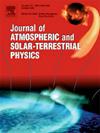城市环境中利用超高速率GNSS观测数据实时检测周跳的新方法
IF 1.9
4区 地球科学
Q3 GEOCHEMISTRY & GEOPHYSICS
Journal of Atmospheric and Solar-Terrestrial Physics
Pub Date : 2025-08-09
DOI:10.1016/j.jastp.2025.106600
引用次数: 0
摘要
全球导航卫星系统(GNSS)使用实时运动学(RTK)或精确点定位(PPP)技术进行精确导航和定位,在城市环境中得到了普及。然而,城市GNSS的性能受到高层建筑多径反射引起的周跳的显著影响。在城市环境中实现可靠的RTK或RTPPP解决方案的主要挑战是准确检测周期滑移。由于多径干扰的不利影响,传统的周跳检测方法往往存在不足。本研究旨在利用超高速率GNSS观测来检测周跳。我们对这些观测结果进行了分析,发现与常用的1 Hz观测结果相比,它们在观测噪声和多径方面表现出较小的变化。利用这一见解,我们提出了一种新的周滑检测方法,该方法消除了基于几何的数学模型中的坐标参数。相反,它只包含一个与接收器时钟相关的参数,增强了它对多径效应的鲁棒性。我们提出的方法利用了超高速率GNSS观测的有利特性。通过排除坐标参数,只关注接收机时钟参数,我们的方法对多径干扰的影响更有弹性。与传统方法相比,这种新方法提供了更好的周跳检测能力。为了评估我们方法的有效性,我们使用50 Hz GNSS观测数据进行了数值实验,包括城市环境中的场景。值得注意的是,我们的新方法取得了几乎完美的周滑检测成功率,接近100%。这些结果证明了我们的方法的有效性,即使在充满挑战的城市环境中也是如此。这项研究的结果表明,在使用超高速率GNSS观测的周跳检测方面取得了重大进展。通过减少对坐标参数的依赖,并考虑到这些观测值的独特特征,我们的方法有望提高GNSS定位的可靠性和准确性,特别是在城市环境中。数值试验结果表明,传统方法可以检测到上述情况,新方法也可以检测到这些情况。本文章由计算机程序翻译,如有差异,请以英文原文为准。
Novel real-time detection method of cycle slips using ultra-high rate GNSS observations in urban environments
The use of Global Navigation Satellite Systems (GNSS) for precise navigation and positioning using Real-Time Kinematic (RTK) or Precise Point Positioning (PPP) techniques has gained popularity in urban environments. However, the performance of GNSS in urban areas is significantly affected by cycle slips caused by multipath reflections from high-rise buildings. Detecting cycle slips accurately becomes a primary challenge for achieving reliable RTK or RTPPP solutions in urban settings. Traditional methods for cycle slip detection often fall short due to the detrimental effects of multipath interference.
This research aims to detect cycle slips utilizing ultra-high rate GNSS observations. We conducted an analysis of these observations and discovered that they exhibit reduced variation in observation noise and multipath compared to commonly used 1 Hz observations. Leveraging this insight, we propose a novel cycle slip detection method that eliminates coordinate parameters from the geometry-based mathematical model. Instead, it incorporates only a single parameter related to the receiver clock, enhancing its robustness against multipath effects.
Our proposed approach leverages the favorable characteristics of ultra-high rate GNSS observations. By excluding coordinate parameters and focusing solely on the receiver clock parameter, our method becomes more resilient to the impacts of multipath interference. This novel methodology offers improved cycle slip detection capabilities compared to traditional methods.
To evaluate the effectiveness of our method, we performed numerical experiments using 50 Hz GNSS observations, including scenarios in urban environments. Remarkably, our new method achieved an almost perfect success rate of cycle slip detection, nearing 100 %. These results demonstrate the efficacy of our approach, even in challenging urban settings.
The findings of this research present a significant advancement in cycle slip detection using ultra-high rate GNSS observations. By reducing the reliance on coordinate parameters and considering the unique characteristics of these observations, our method holds promise for enhancing the reliability and accuracy of GNSS positioning, particularly in urban environments. Numerical test shows that all those cases can be detected with traditional method, can also be detected with the new method.
求助全文
通过发布文献求助,成功后即可免费获取论文全文。
去求助
来源期刊

Journal of Atmospheric and Solar-Terrestrial Physics
地学-地球化学与地球物理
CiteScore
4.10
自引率
5.30%
发文量
95
审稿时长
6 months
期刊介绍:
The Journal of Atmospheric and Solar-Terrestrial Physics (JASTP) is an international journal concerned with the inter-disciplinary science of the Earth''s atmospheric and space environment, especially the highly varied and highly variable physical phenomena that occur in this natural laboratory and the processes that couple them.
The journal covers the physical processes operating in the troposphere, stratosphere, mesosphere, thermosphere, ionosphere, magnetosphere, the Sun, interplanetary medium, and heliosphere. Phenomena occurring in other "spheres", solar influences on climate, and supporting laboratory measurements are also considered. The journal deals especially with the coupling between the different regions.
Solar flares, coronal mass ejections, and other energetic events on the Sun create interesting and important perturbations in the near-Earth space environment. The physics of such "space weather" is central to the Journal of Atmospheric and Solar-Terrestrial Physics and the journal welcomes papers that lead in the direction of a predictive understanding of the coupled system. Regarding the upper atmosphere, the subjects of aeronomy, geomagnetism and geoelectricity, auroral phenomena, radio wave propagation, and plasma instabilities, are examples within the broad field of solar-terrestrial physics which emphasise the energy exchange between the solar wind, the magnetospheric and ionospheric plasmas, and the neutral gas. In the lower atmosphere, topics covered range from mesoscale to global scale dynamics, to atmospheric electricity, lightning and its effects, and to anthropogenic changes.
 求助内容:
求助内容: 应助结果提醒方式:
应助结果提醒方式:


